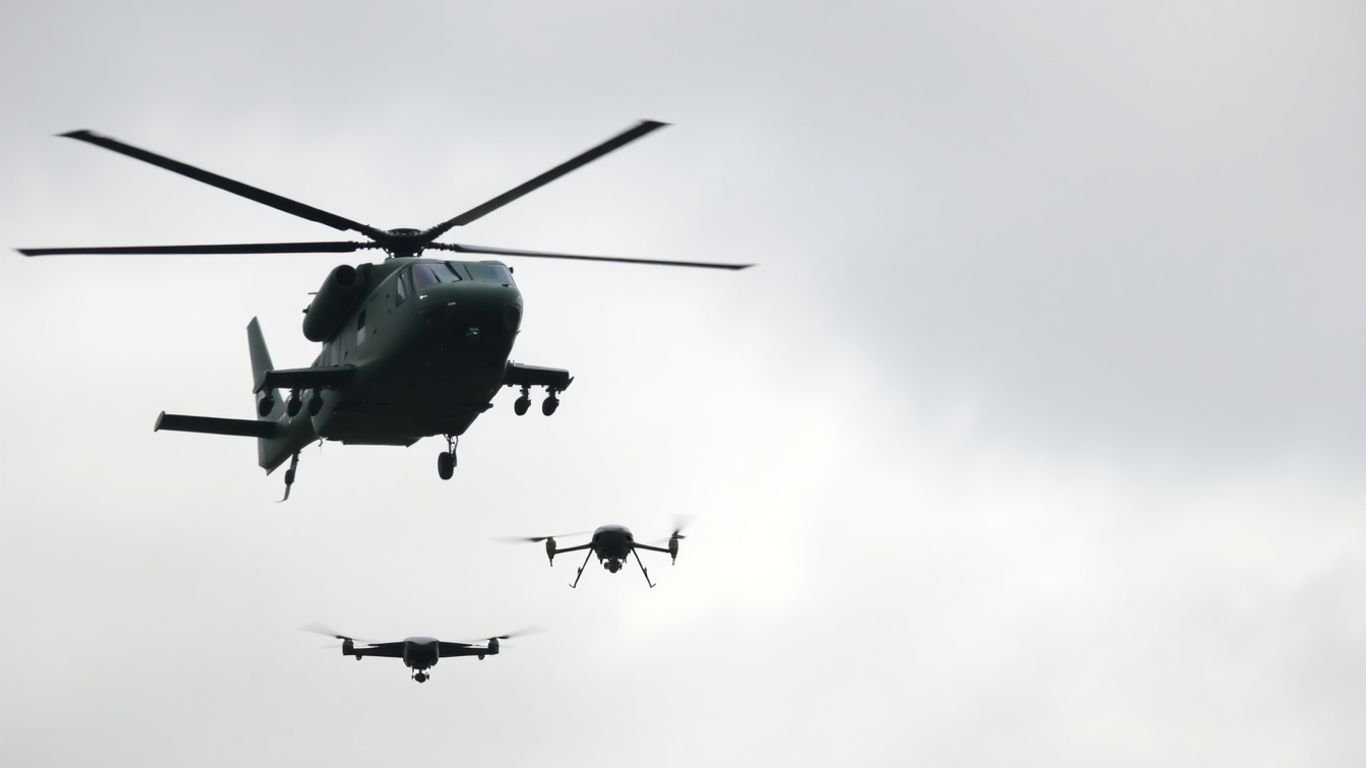Germany Moves to Authorize Armed Forces to Shoot Down Threatening Drones

Germany is stepping up its defense game, and it’s all about dealing with a growing problem: drones. You know, those flying things that seem to be everywhere these days? Well, it turns out they’re becoming a real headache, especially when they show up where they shouldn’t be, like near important places. So, the German government is proposing some pretty big changes to how the military can handle these aerial nuisances. It’s a move that highlights how much things have changed and why being prepared is more important than ever.
Key Takeaways
- Germany is moving to allow its armed forces to shoot down drones that pose a serious threat, especially near critical infrastructure.
- This change comes as illegal drone flights have increased, with suspicions pointing towards state actors potentially involved in sabotage or terrorism.
- The current laws limit the military’s ability to intervene effectively against these drone threats.
- The move is part of a broader shift in Germany’s defense strategy, influenced by geopolitical events like the conflict in Ukraine.
- There’s a growing concern about Germany’s reliance on foreign sources, particularly China, for critical raw materials needed for defense production.
Germany Authorizes Military Action Against Unmanned Aerial Threats
New Legislation Empowers Armed Forces to Intervene
Germany is taking a significant step to bolster its national security by empowering its armed forces to take direct action against threatening unmanned aerial vehicles. This new legislation, a proposed amendment to the Aviation Security Act, will allow the military to shoot down drones under specific, serious circumstances. This move comes in response to a noticeable increase in illegal drone flights over sensitive areas. The goal is to prevent potential sabotage, serious accidents, and threats to life and limb. Previously, intervention methods were limited, often relying on less forceful measures. The German armed forces drone intervention capabilities are set to expand significantly.
Addressing Increased Drone Activity Near Critical Infrastructure
There’s been a worrying rise in unauthorized drone activity, particularly around critical infrastructure like power plants, communication hubs, and major industrial sites. These flights, often suspected to be state-sponsored, pose a direct risk. The proposed law aims to give the military the authority to act when these drones present a clear danger. This is a direct response to incidents that have occurred near military bases, including the US Ramstein Air Base, and other sensitive locations. The situation highlights the growing need for robust defense against aerial threats.
Preventing Serious Accidents and Sabotage Attempts
The core of this legislative change is to prevent catastrophic events. The draft amendment specifically mentions the possibility of drones being used for sabotage or even terrorist purposes, especially since the conflict in Ukraine escalated. Current regulations only permit the military to use softer tactics, such as trying to force drones away or firing warning shots. The new rules would allow for a drone to be shot down if it’s deemed the only way to neutralize a threat to people or vital facilities. This proactive stance is seen as necessary to counter potential acts of air terror.
Escalating Germany Drone Threat Landscape

Lately, there’s been a noticeable uptick in drone activity over Germany, and it’s not just hobbyists getting carried away. The frequency of these unauthorized flights, especially near sensitive locations, has really ramped up. Since the conflict in Ukraine kicked off, we’ve seen a significant rise in these unmanned aerial vehicles making illegal incursions. It’s got officials worried, and for good reason. These aren’t just random fly-bys; there’s a growing suspicion that state actors might be behind some of these operations, potentially looking to cause trouble.
Rise in Illegal Drone Flights Since Ukraine Conflict
It feels like almost overnight, the skies above Germany have become a lot busier with drones, and not always in a good way. The increase in these flights seems directly linked to the ongoing situation in Ukraine. What used to be a rare occurrence is now becoming more common, leading to a real headache for aviation security Germany.
Suspected State Actors Behind Drone Operations
When these drones pop up over places they shouldn’t be, especially near critical infrastructure, the questions start flying. Who is sending them up, and why? There’s a growing concern that these aren’t just accidental flights. Intelligence suggests that some of these high-threat drone intrusions could be orchestrated by foreign governments, possibly for espionage or even sabotage. It’s a worrying thought, and it’s pushing the government to consider new ways to deal with this evolving threat.
Impact on Military Bases and Industrial Sites
These unauthorized drone flights are causing real problems. Military bases, like the US Ramstein Air Base, and major industrial complexes have reported seeing these devices buzzing around. This isn’t just a minor nuisance; it poses a genuine security risk. The potential for these drones to gather intelligence, disrupt operations, or even attempt sabotage is a serious concern. It’s why there’s a push for new drone defense legislation Germany, to give authorities more power to act.
The current methods for dealing with these drones are proving insufficient. When a drone is spotted, the military can only try to steer it away or issue warnings. This lack of decisive action leaves critical sites vulnerable and makes it hard to catch those responsible.
Here’s a look at some recent concerns:
- Increased sightings: Reports of drones over military training areas and industrial zones have become more frequent.
- Potential for sabotage: The nature of some flights suggests a deliberate intent to cause harm or disruption.
- Difficulty in intervention: Current laws limit the military’s ability to effectively neutralize a drone threat.
This situation highlights the need for Germany to adapt its aviation security Germany measures to counter these new aerial challenges.
Evolving Defense Capabilities Against Drones
New Legislation Empowers Armed Forces to Intervene
Things are changing when it comes to how Germany can defend against drones. For a while now, there’s been a growing problem with unauthorized drone flights, especially near places that are really important for the country’s safety. Think power plants, big communication hubs, and major industrial areas. These aren’t just random hobbyists messing around; the government suspects some of these flights might be linked to state actors looking to cause trouble, maybe for sabotage or even worse. The current rules for the military are pretty limited. They can try to nudge drones away or maybe fire warning shots, but that’s about it. It hasn’t been very effective, and catching the people responsible is tough.
Addressing Increased Drone Activity Near Critical Infrastructure
This new shoot down drones law is a big deal because it gives the military more options. It’s not like they can just blast any drone out of the sky. There are specific conditions. The main idea is to protect critical infrastructure protection drones and prevent serious harm. If a drone is seen as a real threat, posing a danger to people’s lives or to these vital facilities, and other methods won’t work, then the armed forces might get the go-ahead to take it down. This is a direct response to a noticeable uptick in these kinds of incidents, particularly since the conflict in Ukraine started. It’s about having a more robust way to deal with aerial threats that current police capabilities can’t handle.
Preventing Serious Accidents and Sabotage Attempts
So, what does this mean in practice? Well, the military will have the authority to use force, including shooting down drones, if they believe it’s the only way to stop a major incident. This isn’t about everyday drone use; it’s about those specific, high-risk situations. The goal is to stop potential sabotage, prevent serious accidents that could happen if a drone interferes with sensitive equipment, and generally keep the skies safer over important national sites. It’s a shift towards a more proactive defense posture against these unmanned aerial threats.
International Concerns and Russian Aggression

It’s getting a bit tense out there, isn’t it? Especially with all the talk about Russia and what they might be up to. Since the whole situation in Ukraine kicked off, there’s been a noticeable uptick in drone activity, and not just any drones – the kind that make you wonder what’s really going on. Western security folks are pointing fingers, suggesting that Russia’s military intelligence might be behind some of these incidents. They’re talking about a sort of ‘shadow war,’ where these unmanned aerial vehicles are used for more than just spying. Think sabotage attempts, maybe even trying to mess with flights or critical infrastructure. It’s a worrying trend, and it’s not just Germany feeling it.
Allegations of Russian ‘Shadow War’ Tactics
There’s a growing suspicion that Russia is employing tactics that go beyond traditional warfare. Reports suggest a coordinated effort to disrupt Western nations, particularly those supporting Ukraine. This includes alleged attempts to interfere with air travel and damage important facilities. It’s like they’re trying to poke and prod, testing the boundaries and seeing what they can get away with. The idea of a ‘shadow war’ implies a deliberate, covert campaign designed to destabilize and sow discord.
Concerns Over Sabotage and Terrorist Intentions
This isn’t just about a few rogue drones flying around. The concern is that these activities could be precursors to more serious attacks. We’ve seen reports of parcel fires in Europe, which some believe were practice runs for larger sabotage operations targeting flights. The potential for these drones to be used for espionage, or worse, for terrorist acts, is a real worry. It means that the threat isn’t just to military sites, but potentially to civilian areas and public safety as well.
Broader Geopolitical Implications for Europe
What happens in one country often has ripple effects across the continent. Germany’s move to authorize its armed forces to take down threatening drones is part of a larger picture. It signals a shift in how European nations are preparing for these new kinds of threats. It’s not just about defending borders anymore; it’s about protecting critical infrastructure and maintaining stability in the face of unconventional aggression. This could lead to more countries reassessing their own defense strategies and capabilities, especially concerning aerial threats. It’s a complex situation, and everyone’s watching to see how it plays out.
Strategic Importance of Critical Raw Materials
It turns out that all those fancy new tanks, missiles, and even the drones Germany wants to shoot down, they all need some pretty specific stuff to be made. We’re talking about materials like neodymium, dysprosium, tungsten, and titanium. These aren’t exactly things you find at your local hardware store. They’re the backbone of modern military tech, powering everything from radar systems to the motors in drones.
Dependency on China for Defense Industry Components
The big issue here is where these materials come from. Right now, a huge chunk of them, and more importantly, the processing of them, is controlled by China. We’re talking about importing 95 percent of these strategic raw materials into the EU, and a massive 90 percent of that comes from outside the EU. Germany’s own ability to process these materials is practically zero. China, on the other hand, handles over half of the world’s processing for many of these critical minerals, and for some really important ones for defense, it’s as high as 86 percent. This reliance is a serious problem.
Vulnerability of Military Supply Chains
This dependency creates a real weak spot. If China were to suddenly cut off or restrict exports, which they’ve hinted at doing before, it could bring Germany’s entire rearmament plan to a screeching halt. It’s not just about having the raw stuff; it’s about having a reliable way to get it and process it. The current situation means that Germany, and really all of Europe, is vulnerable. It’s like building a strong house but relying on a single, shaky pillar for support.
Need for Domestic Resource Development
So, what’s the answer? Well, some folks are saying Germany needs to look inward. This means exploring and reactivating its own natural resources, like lithium deposits that are currently just sitting there. It also means getting over the political hurdles that make domestic mining so difficult. Building national stockpiles is a good short-term fix, sure, but it’s not a long-term solution. True resilience means changing the system, making sure Germany can produce its own defense components without being held hostage by global supply chain issues. It’s about taking control of its own security.
The current approach from the EU, while well-intentioned, seems to be getting bogged down in bureaucracy. It names the problem but doesn’t really solve it. National governments need to step up and make concrete decisions, especially when it comes to defense needs.
Here’s a look at some of the key materials and their uses:
- Neodymium and Dysprosium: Used in powerful magnets for electric motors and generators, essential for vehicle propulsion and advanced electronics.
- Tungsten: Critical for armor-piercing projectiles due to its density and hardness.
- Titanium: Valued for its strength-to-weight ratio, used in aircraft frames and high-stress components.
- Gallium and Germanium: Important for semiconductors and high-frequency electronics used in radar and communication systems.
It’s clear that without a secure supply of these materials, Germany’s ambition to become a leading military power in Europe is on shaky ground. It’s a complex problem that requires a serious, strategic rethink.
Germany’s Shifting Defense Posture
Germany is really changing how it thinks about defense these days. It’s not just about having a military anymore; it’s about being a serious player on the world stage. After what happened in Ukraine, the country realized it couldn’t just sit back and hope for the best. There’s a big push to make the German armed forces the strongest in Europe, and that means spending a lot more money – we’re talking billions over the next few years. This is a huge change from how things used to be, with a lot less focus on military spending.
Commitment to Strengthening Armed Forces
This isn’t just talk. Orders for new military gear are piling up, from vehicles to missiles and ammo. Defense companies are busy getting their factories ready and firing up old production lines that haven’t been used in ages. It’s like they’re trying to bring back an industrial base that kind of faded away after the Cold War. The goal is to build a military that can actually stand up to modern threats.
Reactivating Industrial Base for Defense Production
But here’s the tricky part: all this new equipment, like tanks, missiles, and yes, even those drones we’re talking about, needs special materials. Think rare earth elements, tungsten, graphite, and high-purity magnesium. These are the things that make radar systems, electric motors, and guidance systems work. The problem is, most of these materials come from China. The Federation of German Industries (BDI) points out that the EU imports a massive 95% of its strategic raw materials, and 90% of those come from outside the EU. Germany itself doesn’t really process much of this stuff. China, on the other hand, controls a huge chunk of the global processing for many of these critical minerals.
Rethinking Geopolitical Strategy and Preparedness
The reliance on foreign sources for materials vital to national defense is a serious concern. Without a steady supply of these components, Germany’s plans to bolster its military capabilities could be seriously hampered. It’s a wake-up call that security isn’t just about having soldiers and tanks, but also about controlling the resources needed to build and maintain them.
This dependency is a big worry. If China were to suddenly cut off supplies, it could bring defense production to a halt. Some politicians are pushing for Germany to take more control, suggesting things like creating national stockpiles of these materials and even looking into domestic mining. It’s a complex issue, balancing the need for a strong defense with the reality of global supply chains. The country is definitely trying to figure out a new way forward, one that’s less reliant on others for its security.
What This Means Going Forward
So, Germany’s getting ready to let its military take down drones that are flying around where they shouldn’t be, especially near important places like power plants or military bases. It seems like this whole drone situation has gotten a lot more common lately, and frankly, the police haven’t really had the tools to deal with it. This new plan is a pretty big step, and it’s definitely something to keep an eye on as things develop. It’s all part of a larger shift in how Germany is thinking about its defense, especially with everything going on in the world.
Frequently Asked Questions
Why is Germany allowing its military to shoot down drones?
Germany is updating its laws because there’s been a big increase in drones flying where they shouldn’t, especially near important places like power plants and military bases. These drones might be used for spying or causing harm, and the government wants to be able to stop them to protect people and key facilities.
What kind of drones are they worried about?
They are concerned about drones that fly illegally, particularly those suspected of being operated by state actors for purposes like sabotage or even terrorism. This includes drones seen near military training areas, sensitive industrial sites, and major air bases.
Can the military shoot down any drone they see?
No, the military can only use force, including shooting down a drone, if it’s seen as the only way to prevent a very serious accident or danger to people’s lives. It’s meant for situations where lesser measures, like trying to steer the drone away, haven’t worked or aren’t enough.
What’s the difference between what police and the military can do?
Currently, police have more authority for everyday drone issues. The new rules specifically empower the military to act in more serious situations where there’s a clear threat to critical infrastructure or public safety, which goes beyond the police’s usual capabilities or technology.
Is this related to the war in Ukraine?
Yes, officials have noted a significant rise in drone incidents since Russia’s invasion of Ukraine. This has led to concerns about potential ‘shadow war’ tactics, including sabotage attempts, not just in Germany but across Europe.
Does this mean Germany is changing its military strategy?
This is part of a larger shift in Germany’s defense approach. The country is investing more in its armed forces and looking to strengthen its ability to produce military equipment. This also includes addressing vulnerabilities, like the reliance on other countries, especially China, for important raw materials needed for defense technology.






